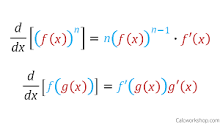Find the derivative of y=5
By using the formula for the Derivative of a Constant Function:
You can solve this problem with one arm tied behind your back! y=5 is a horizontal line, where every x-value has a y-value of 5. Since horizontal lines have no change in y, the slope will always be zero. This means that if you find the derivative of any constant, the answer will always be zero.
Differentiate f(x)=x3
This is the Power Rule for Positive Integer Powers of X. The formula is:
![]()
This is a 3 step problem-
1. Move the exponent to the front of the function
3x3
2. Subtract the exponent by one
3-1=2
3. Put the new exponent back where it was
The final answer is 3x2
Give this one a go!
Differentiate f(x)=6x4
The answer should be 24x3
Since you know the power rule, you know to multiply the exponent by the coefficient, and then subtract the exponent by one. The Constant Multiple Rule proves this, by saying that you can just multiply whatever the derivative of the function is, multiplied by the coefficient. Here is the formula:
![]()
The derivative of x4 is just 4x3. Next you just multiply the coefficient, 6, by that derivative. This will give you 24x3
Try to solve this one:
d/dx (x2 + 5)
This is a classic sum and difference rule problem. To solve it, interpret this formula
What this is saying, is that you can find the derivative of the whole equation by splitting it into parts. For the solution to the problem, follow these steps:
1.d/dx (x2) + d/dx(5)
2.Comes out as 2x1 + 0
Final answer is 2x
Guess Which rule applies to this problem. Next, try to solve it.
f'(x)=sin(x)(cos(x))
Look at this formula for help!
(fg)′=f′g+fg′
How did you know! This is the Product Rule
To solve, you can take the derivative of each piece and then add them.
f'(x)= f'(sinx) + f'(cosx)
This problem can be simplified more, but for all intents and purposes it will remain as is.
Try this one...
d/dx f(x)=999,435,001
Yup. Easy. The answer is 0
Try this one out:
d/dx y=cos(x)10
y'=-10sin(x)cos(x)9
Eezy Peezy
Here's another one to try:
y=10x3
y'=?
Did you get y'=30x2?
I bet you can't solve this!
d/dx(x-9 + -x-2)
Good job. You proved me wrong. The answer should be -9x-10 + 2x-3
Guess Which rule applies to this problem. Next, try to solve it.

Wow your getting good at this game! If you didn't guess it, this is the Quotient Rule. The way to solve this type of problem, is by learning the following trick:
(Low x DHigh) - (High x DLow) over Low2
This means that you take the top of the function and multiply it by the derivative of the bottom, then subtract that from the bottom of the function multiplied by the derivative of the top. All of this is divided by the bottom of the function squared.
This formula might make it easier to understand The answer to the problem is ((x+1)(1)-(x+1)(1))/(x-1)2
The answer to the problem is ((x+1)(1)-(x+1)(1))/(x-1)2
P.S.
No need to simplify your answers btw (only for these problems though)
Differentiate y=π
(that's a pi symbol)
The answer is zero, once again!
g(x) = x-4
This question is an example of the Power Rule for Negative Integer Powers of X. The formula is the same, so you just keep doing the same thing, except you subtract from negative n.
![]()
The correct answer is:
g'(x) = -4x-5
Find the derivative of y=4x
4? Yeah I thought so too!
Differentiate y=(x-4 + x5)
If you follow the rules, you will get -4x-5 + 5x4
Here comes another Quotient Rule problem
Differentiate:
![]()
According to that low DHigh thing, the correct answer is ((3x-1)(2x) - (x2)(x))/(3x-1)2
d/dx g(x)=2.718281
Zero....Again...
Noticing the pattern yet?
How about :
d/dx y=sin(x)2
Is it just me or do these get kind of boring after the second question?
The answer is y'=2sin(x)cos(x)
Can you differentiate: y=5x5
I believe the answer is 25x4
Here is ANOTHER
Differentiate f(x)=(-4x-4-4x4)
The correct answer is 16x-5-16x3
Guess Which rule applies to this problem. Next, try to solve it.
f(x)=(6x2+7x)4
Here's a hint:

Stop it. Stop it. Your just too good. This, obviously is the Chain Rule.
Here are the steps to get the final answer:
1. Use the power rule, to get 4(6x2+7x)3
2.Take the derivative of the inside function, 12x + 7
3. Multiply the two, to end up with 4(6x2+7x)3 (12x + 7)
Last one: y=12345678987654321
Yeah, this is boring me too. 0 again.
Last Question!
f(x)=xe
You got it! f'(x)=exe-1
Last one.
f(x)=0x0
I think its zero, right?
Yup it is.
Here we go again!
y=(tan(x)-4x-3)
Did you get something like sec2(x) +12x-4
This problem has multiple derivative rules inside it. Try to guess which rules are being used, and then solve it!
f(x) = (2x4+8x-2)4/sin(x)-3
Find f'(x)
This one is pretty complicated. Lets start by using the quotient rule. By using the Low DHigh technique, you should get ((4x-3)(DHigh) - (2x4+8x-2)4(-12x-4) ) / (sin(x)-3)2
Next, use the chain rule to find the part of the equation I left out above, a.k.a. the derivative of the top: 4(2x4+8x-2)(8x3 + -16x-3).
Now, put all the pieces together:
f'(x)=((4x-3)(4(2x4+8x-2)(8x3 + -16x-3)) - (2x4+8x-2)4(-12x-4) ) / sin(x)-6
WOW, that's complicated!